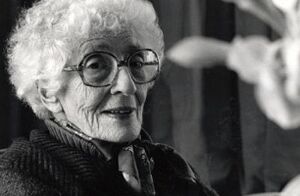May Sarton facts for kids
Quick facts for kids
May Sarton
|
|
|---|---|
 |
|
| Born | Eleanore Marie Sarton May 3, 1912 Wondelgem, Belgium |
| Died | July 16, 1995 (aged 83) York, Maine, US |
| Occupation |
|
| Nationality | Belgian, American |
| Genre | Fiction, poetry, non-fiction, children's literature |
| Partner | Judy Matlack |
May Sarton was the pen name for Eleanore Marie Sarton. She was a Belgian-American writer, known for her novels, poems, and memoirs. She was born on May 3, 1912, and passed away on July 16, 1995.
Contents
About May Sarton's Life
May Sarton was born in Wondelgem, Belgium. This area is now part of the city of Ghent. She was the only child of George Sarton, a historian of science, and Mabel Eleanor Elwes, an English artist.
Early Life and Moving to America
In 1914, when May was very young, German troops entered Belgium. Her family had to leave their home. They fled to Ipswich, England, where her grandmother lived.
A year later, her family moved to Boston, Massachusetts. Her father began working at Harvard University. May went to school in Cambridge, Massachusetts. She graduated from Cambridge Latin High School in 1929.
Discovering Her Passion for Writing
May Sarton loved writing poetry even when she was a teenager. She also took theater lessons. She won a scholarship to Vassar College. However, she felt very drawn to the theater. This happened after she saw Eva Le Gallienne perform in a play called The Cradle Song.
May decided to join Le Gallienne's Civic Repertory Theatre in New York City. She worked there as an apprentice for a year. But she never stopped writing poetry. When she was seventeen, she published some sonnets in December 1930. Some of these poems were later included in her first book, Encounter in April (1937).
Travels and First Novel
When May was nineteen, she traveled to Europe. She lived in Paris for a year. During this time, she met many famous writers and artists. These included Virginia Woolf and Elizabeth Bowen. In this exciting environment, she published her first novel. It was called The Single Hound (1938).
Later Life and Journals
In 1945, May Sarton met Judith "Judy" Matlack in Santa Fe, New Mexico. Judy became a very close companion for thirteen years. They separated in 1956, after May's father passed away. May then moved to Nelson, New Hampshire. Her book Honey in the Hive (1988) tells about their friendship.
May Sarton later moved to York, Maine. In 1990, she had a stroke. This made writing difficult for her. So, she used a tape recorder to record her thoughts. These recordings became her journal, Endgame: A Journal of the Seventy-Ninth Year (1992).
Even with physical challenges, she stayed independent. Endgame was followed by another journal, Encore: A Journal of the Eightieth Year (1993). This book celebrated May Sarton's life. She won the Levinson Prize for Poetry in 1993. Her last book, Coming Into Eighty (1995), was published after she died. It describes her thankfulness for life as she grew older.
May Sarton passed away on July 16, 1995, from breast cancer. She is buried in Nelson Cemetery, Nelson, New Hampshire.
May Sarton's Works and Themes
May Sarton was a very productive writer. She wrote 53 books in total. This included 19 novels, 17 books of poetry, and 15 non-fiction works. She also wrote 2 children's books, a play, and some screenplays.
Writing Style and Important Works
Critics often described Sarton's writing style as "calm, cultured, and urbane." While she sometimes wrote about political topics, her most famous works are her journals and memoirs. These include:
- Plant Dreaming Deep (about her early years in Nelson)
- Journal of a Solitude (1972–1973), which many consider her best work
- The House by the Sea (1974–1976)
- Recovering (1978–1979)
- At Seventy (1982–1983)
Themes in Her Writing
In these honest accounts of her life, May Sarton explored many important topics. She wrote about:
- Growing older
- Being alone and finding peace in solitude
- The importance of friendship and relationships
- Dealing with self-doubt
- Experiencing success and failure
- Feeling thankful for simple joys in life
- Her love for nature, especially flowers
- The changing seasons
- Spirituality
- The constant challenges of being a creative artist
Later in her life, her journals were not quite the same quality. This was because she continued writing even when she was ill, often by dictating her thoughts.

